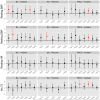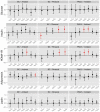Extreme Air Pollution Conditions Adversely Affect Blood Pressure and Insulin Resistance: The Air Pollution and Cardiometabolic Disease Study
- PMID: 26573709
- PMCID: PMC4830086
- DOI: 10.1161/HYPERTENSIONAHA.115.06237
Extreme Air Pollution Conditions Adversely Affect Blood Pressure and Insulin Resistance: The Air Pollution and Cardiometabolic Disease Study
Abstract
Mounting evidence supports that fine particulate matter adversely affects cardiometabolic diseases particularly in susceptible individuals; however, health effects induced by the extreme concentrations within megacities in Asia are not well described. We enrolled 65 nonsmoking adults with metabolic syndrome and insulin resistance in the Beijing metropolitan area into a panel study of 4 repeated visits across 4 seasons since 2012. Daily ambient fine particulate matter and personal black carbon levels ranged from 9.0 to 552.5 µg/m(3) and 0.2 to 24.5 µg/m(3), respectively, with extreme levels observed during January 2013. Cumulative fine particulate matter exposure windows across the prior 1 to 7 days were significantly associated with systolic blood pressure elevations ranging from 2.0 (95% confidence interval, 0.3-3.7) to 2.7 (0.6-4.8) mm Hg per SD increase (67.2 µg/m(3)), whereas cumulative black carbon exposure during the previous 2 to 5 days were significantly associated with ranges in elevations in diastolic blood pressure from 1.3 (0.0-2.5) to 1.7 (0.3-3.2) mm Hg per SD increase (3.6 µg/m(3)). Both black carbon and fine particulate matter were significantly associated with worsening insulin resistance (0.18 [0.01-0.36] and 0.22 [0.04-0.39] unit increase per SD increase of personal-level black carbon and 0.18 [0.02-0.34] and 0.22 [0.08-0.36] unit increase per SD increase of ambient fine particulate matter on lag days 4 and 5). These results provide important global public health warnings that air pollution may pose a risk to cardiometabolic health even at the extremely high concentrations faced by billions of people in the developing world today.
Keywords: air pollution; diabetes mellitus; hypertension; insulin resistance; metabolism.
© 2015 American Heart Association, Inc.
Figures



Similar articles
-
Personal black carbon exposure influences ambulatory blood pressure: air pollution and cardiometabolic disease (AIRCMD-China) study.Hypertension. 2014 Apr;63(4):871-7. doi: 10.1161/HYPERTENSIONAHA.113.02588. Epub 2014 Jan 13. Hypertension. 2014. PMID: 24420543 Free PMC article.
-
Multicity study of air pollution and mortality in Latin America (the ESCALA study).Res Rep Health Eff Inst. 2012 Oct;(171):5-86. Res Rep Health Eff Inst. 2012. PMID: 23311234
-
Susceptibility of prediabetes to the health effect of air pollution: a community-based panel study with a nested case-control design.Environ Health. 2019 Jul 15;18(1):65. doi: 10.1186/s12940-019-0502-6. Environ Health. 2019. PMID: 31307478 Free PMC article.
-
Air pollution and children's health-a review of adverse effects associated with prenatal exposure from fine to ultrafine particulate matter.Environ Health Prev Med. 2021 Jul 12;26(1):72. doi: 10.1186/s12199-021-00995-5. Environ Health Prev Med. 2021. PMID: 34253165 Free PMC article. Review.
-
Air Pollution and Cardiometabolic Disease: An Update and Call for Clinical Trials.Am J Hypertens. 2017 Dec 8;31(1):1-10. doi: 10.1093/ajh/hpx109. Am J Hypertens. 2017. PMID: 28655143 Free PMC article. Review.
Cited by
-
Overview of particulate air pollution and human health in China: Evidence, challenges, and opportunities.Innovation (Camb). 2022 Sep 6;3(6):100312. doi: 10.1016/j.xinn.2022.100312. eCollection 2022 Nov 8. Innovation (Camb). 2022. PMID: 36160941 Free PMC article. Review.
-
Ambient and Traffic-Related Air Pollution Exposures as Novel Risk Factors for Metabolic Dysfunction and Type 2 Diabetes.Curr Epidemiol Rep. 2018 Jun;5(2):79-91. doi: 10.1007/s40471-018-0140-5. Epub 2018 Apr 10. Curr Epidemiol Rep. 2018. PMID: 30319933 Free PMC article.
-
Association between Exposure to Ambient Air Particulates and Metabolic Syndrome Components in a Saudi Arabian Population.Int J Environ Res Public Health. 2017 Dec 25;15(1):27. doi: 10.3390/ijerph15010027. Int J Environ Res Public Health. 2017. PMID: 29295575 Free PMC article.
-
Underutilized and Under Threat: Environmental Policy as a Tool to Address Diabetes Risk.Curr Diab Rep. 2018 Mar 26;18(5):25. doi: 10.1007/s11892-018-0993-5. Curr Diab Rep. 2018. PMID: 29582168 Free PMC article. Review.
-
Association between Short-Term Exposure to Air Pollution and Dyslipidemias among Type 2 Diabetic Patients in Northwest China: A Population-Based Study.Int J Environ Res Public Health. 2018 Mar 30;15(4):631. doi: 10.3390/ijerph15040631. Int J Environ Res Public Health. 2018. PMID: 29601472 Free PMC article.
References
-
- Lim SS, Vos T, Flaxman AD, Danaei G, Shibuya K, Adair-Rohani H, Amann M, Anderson HR, Andrews KG, Aryee M, et al. A comparative risk assessment of burden of disease and injury attributable to 67 risk factors and risk factor clusters in 21 regions, 1990-2010: a systematic analysis for the Global Burden of Disease Study 2010. Lancet. 2012;380:2224–2260. - PMC - PubMed
-
- Mustafic H, Jabre P, Caussin C, Murad MH, Escolano S, Tafflet M, Perier MC, Marijon E, Vernerey D, Empana JP, et al. Main air pollutants and myocardial infarction: a systematic review and meta-analysis. Jama. 2012;307(7):713–721. - PubMed
-
- Crouse DL, Peters PA, van Donkelaar A, Goldberg MS, Villeneuve PJ, Brion O, Khan S, Atari DO, Jerrett M, Pope CA, et al. Risk of nonaccidental and cardiovascular mortality in relation to long-term exposure to low concentrations of fine particulate matter: a Canadian national-level cohort study. Environ Health Perspect. 2012;120(5):708–714. - PMC - PubMed
Publication types
MeSH terms
Substances
Grants and funding
LinkOut - more resources
Full Text Sources
Other Literature Sources
Medical

